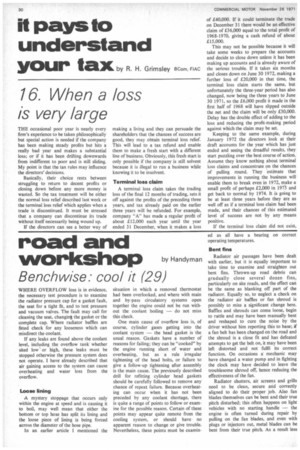road and
Page 30

Page 31

If you've noticed an error in this article please click here to report it so we can fix it.
workshop by Handyman
Benchwise: cool it (29)
WHERE OVERFLOW loss is in evidence, the necessary test procedure is to examine the radiator pressure cap for a gasket fault, the seat for a tight fit, and to test pressure and vacuum valves. The fault may call for cleaning the seat, changint the gasket or the complete cap. Where radiator baffles are fitted check for any looseness which can misdirect the coolant.
If any leaks are found above the coolant level, including the overflow tank whether sited low or high, these leaks must be stopped otherwise the pressure system does not operate. I have already described that air gaining access to the system can cause overheating and water loss from the overflow.
Loose lining A mystery stoppage that occurs only within the engine at speed and is causing it to boil, may well mean that either the bottom or top hose has split its lining and the loose piece of lining is being forced across the diameter of the hose Pipe.
In an earlier article I mentioned the situation in which a removed thermostat had been overlooked, and where with main and by-pass circulatory systems open together the engine could not be run without the coolant boiling — do not miss this check.
One main cause of overflow loss is, of course, cylinder gases getting into the coolant system — the head gasket is the usual reason. Gaskets have a number of reasons for failing; they can be "cooked" by the engine running short of water and overheating, but as a rule irregular tightening of the head bolts, or failure to give a follow-up tightening after assembly is the main cause. The previously described drill for refitting cylinder head gaskets should be carefully followed to remove any chance of repeat failure. Because overheating can occur when it has not been preceded by any coolant shortage, there is quite a range of points to follow or examine for the possible reason. Certain of these points may appear quite remote from the cooling system, or should have no apparent reason to change or give trouble. Nevertheless, these points must be examin ed as all have a bearing on correct operating temperatures.
Bent fins
Radiator air passages have been dealt with earlier, but it is equally important to take time to examine and straighten Out bent fins. Thrown-up road debris can gradually close several dozen fins, particularly on site roads, and the effect can be the same as blanking off part of the radiator. Equally so, to neglect a check on the radiator air baffles or fan shroud is possibly to miss a significant change here. Baffles and shrouds can come loose, begin to rattle and may have been manually bent and reshaped to cure the noise by the driver without him reporting this to base; if a fan belt has been changed on the road and the shroud is a close fit and has defeated attempts to get the belt on, it may have been left distorted and not fulfil its correct function. On occasions a mechanic may have changed a water pump and in fighting the clock may have decided to leave the troublesome shroud off, hence reducing the effectiveness of the fan.
Radiator shutters, air screens and grills need to be clean, secure and correctly aligned to do their proper job. Also fan blades themselves can be bent and their true pitch disturbed; this often happens on light vehicles with no starting handle — the engine is often turned during repair by pulling on the fan blades, and even with plugs or injectors out, metal blades can be bent from their true pitch. As a result less
air is drawn through the radiator.
On petrol engines, ignition timing is critical and late timing can cause full-throttle overheating, so check centrifugal and vacuum spark advance systems for correct operation. Many vacuum systems are very lightly piped and constructed, rubber or plastic pipe having been simply pushed over a small bore adaptor or pipe and a small amount of rubber or fabric across the opening can be enough to prevent the ignition advance functioning, just as broken or lazy springs on the centrifugal mechanism can cause the timing to lag. A sloppy fitting rotor on the distributor shaft can have the same effect.
These items may not be enough in themselves to cause serious boiling but they can combine to give an under par engine. At the other end of the vehicle the exhaust and silencer system is worth a check, as a build-up of back pressure can cause general overheating, so any loose or moving silencer baffles should be made secure.
Obviously, the pump impeller and its blades are most important and quite small amounts which have broken or corroded off the blades can retard the movement of water.
Finally, do not overlook valve timing and rocker adjustment: valves must open fully at the correct point to maintain optimum efficiency, otherwise the engine is neither breathing nor being scavenged cleanly and a heat build-up can arise during maintained full-throttle operation: this is a common cause of motorway stoppages.


















































































